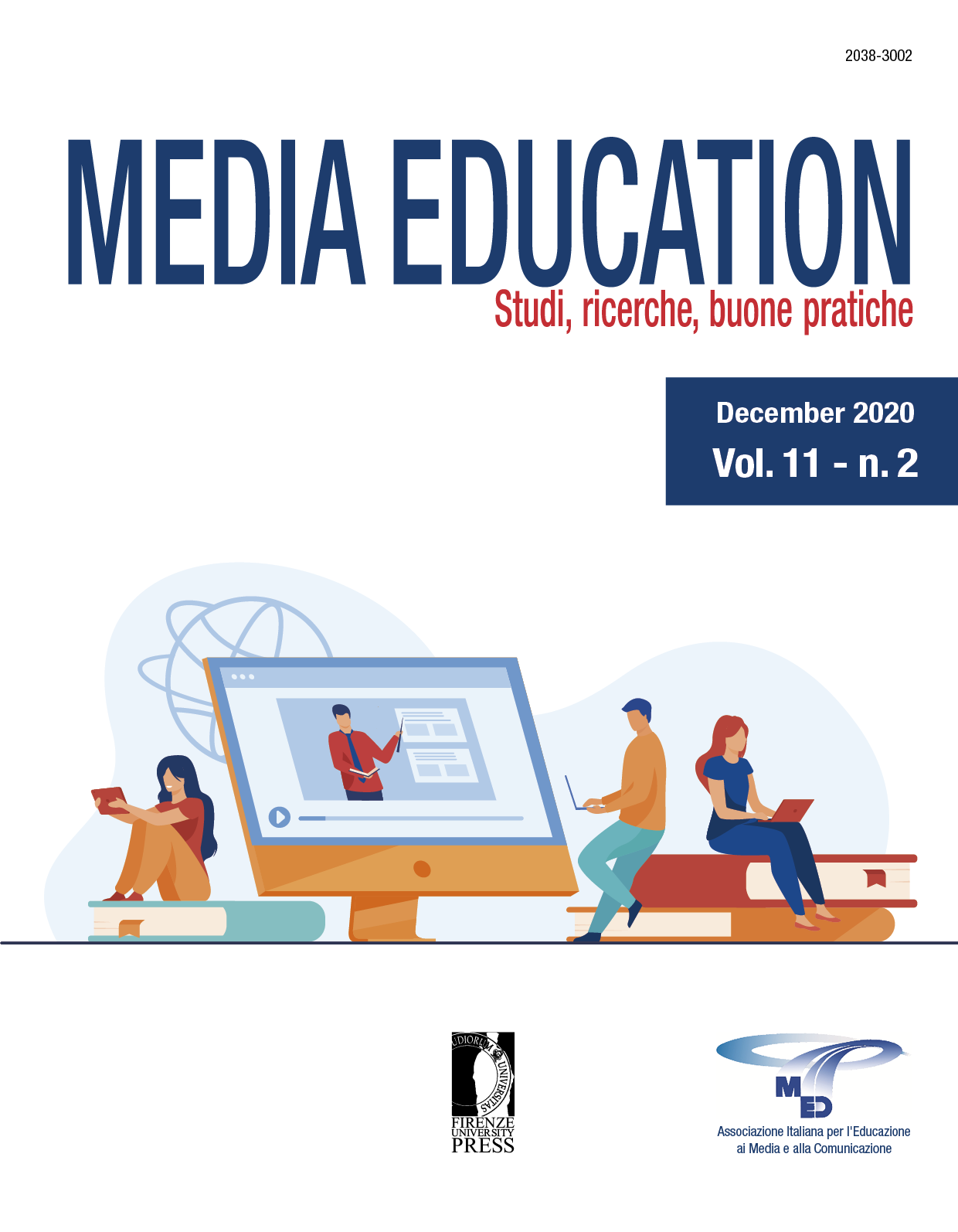Published 2020-11-02
Keywords
- e-learning,
- higher education,
- italian students,
- Student Response System
Abstract
The COVID-19 pandemic situation that overwhelmed us still strongly questions university teaching today. The research reports a classroom’s activity based on self-assessment (SA) and peer-feedback (PF)activities. The result is connected to the combination of three key points for effective teaching: 1) an active role of the students involved in the activity, 2) an effective use of technology based on a Student Response System (SRS), and 3) a sustained pedagogical training for teachers suddenly catapulted to new teaching methods. The design used, developed in the Italian university context, can be developed totally online, guaranteeing new skills and new learning, in view of a hypothetical, and not so unexpected, return to distance learning.
References
Aricò, F. (2016). Promoting active learning through peer-instruction and self-assessment: A toolkit to design, support and evaluate teaching. Educational Developments, 17(1), 15-18.
Boud, D., & Falchikov, N. (2007). Rethinking Assessment in Higher Education: Learning for the Longer Term. London: Routledge.
Boud, D., & Molloy, E. (2013). Rethinking models of feedback for learning: the challenge of design. Assessment & Evaluation in Higher Education, 38(6), 698-712.
Bretones, A.(2008). Participación del alumnado de educación superior en su evaluación. Revista de Educación, 347, Septiembre-diciembre, pp. 181-202.
Brown, J. K. (2008). Student-centered instruction: Involving students in their own education. Music Educators Journal, 94(5), 30-35.
Cartney, P. (2010). Making changes to assessment methods in social work education: Focusing on process and outcome. Social Work Education, 29(2), 137-151.
Calatayud, M.A. (2007). La evaluación como instrumento de aprendizaje y mejora. Una luz a fondo en Calatayud, M.A (dir) et al, La evaluación como instrumento de aprendizaje. Técnicas y estrategias, pp. 9-54. Madrid: Ministerio de Educación y Ciencia.
Cho, K., & MacArthur, C. (2010). Student revision with peer and expert reviewing. Learning and instruction, 20(4), 328-338.
Dochy, F., Segers, M., & Sluijsmans, D. (1999). The Use of Self-, Peer and Co-assessment in Higher Education: A Review, Studies in Higher Education 24 (3): 331–350.
Gibbs G. (1999). Using Assessment Strategically to Change the Way Students Learn. In S. Brown and A. Glasner (Eds.), Assessment matters in higher education (pp. 41-53). Buckingham: Open University Press.
Grion, V., Serbati, A., Tino, C., & Nicol, D. (2018). Ripensare la teoria della valutazione e dell’apprendimento all’università: un modello per implementare pratiche di peer review. Italian Journal of Educational Research, (19), 209-226.
Liu, N. F., & Carless, D. (2006). Peer feedback: the learning element of peer assessment. Teaching in Higher education, 11(3), 279-290.
Mazur, E. (1997) Peer Instruction: A User's Manual. Prentice Hall, NJ.
Nicol, D. J. (2009) Assessment for learner self‐regulation: enhancing achievement in the first year using learning technologies, Assessment & valuation in Higher Education, 34:3, 335-352.
Nicol D. J. (2010). From monologue to dialogue: improving written feedback processes in mass higher education. Assessment & Evaluation in Higher Education, 35(5), 501-517.
Nicol, D. J., & Macfarlane‐Dick, D. (2006). Formative assessment and self‐regulated learning: A model and seven principles of good feedback practice. Studies in higher education, 31(2), 199-218.
Nicol D.J., Thomson A., Breslin C. (2014). Rethinking feedback practices in higher education: a peer review perspective. Assessment & Evaluation in Higher Education, 39 (1), 102-122.
Pérez, A., Tabernero, B., López, V. M., Ureña, N., Ruiz, E., Caplloch, M., González, N. y Castejón, F. J. (2008). Evaluación formativa y compartida en la docencia universitaria y el espacio europeo de educación superior: cuestiones clave para su puesta en práctica. Revista de Educación, num. 347, 435-451. Madrid: MEC.
Ricchiardi, P. (2005). La qualità della didattica e gli “effetti” rilevabili negli studenti: modelli teorici. In C. Coggi (Ed.), Per migliorare la didattica universitaria (pp. 253-304). Lecce: Pensa MultiMedia.
Sadler, D. R. (1998) Formative assessment: revisiting the territory, Assessment in Education, 5(1), 77–84.
Topping, K. (1998). Peer assessment between students in colleges and universities. Review of educational Research, 68(3), 249-276.
Wanner, T., & Palmer, E. (2018). Formative self-and peer assessment for improved student learning: the crucial factors of design, teacher participation and feedback. Assessment & Evaluation in Higher Education, 43(7), 1032-1047.
Yorke, M., & Longden, B. (2004). Retention and student success in higher education. McGraw-Hill Education (UK).
Yorke, M. (2005). Increasing the chances of student success. In Improving student learning 12: Diversity and inclusivity, ed. C. Rust, 35–52. Oxford: Oxford Centre for Staff and Learning Development.

